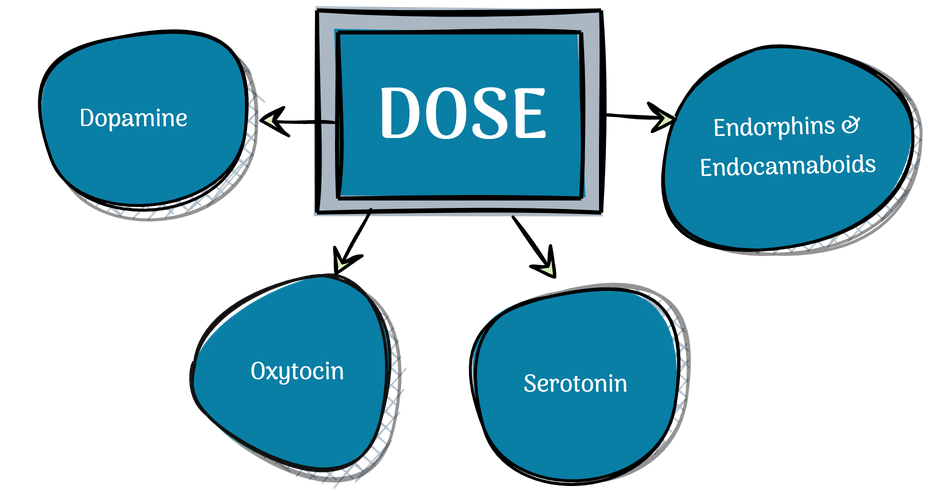It’s easy to romanticize happiness. Aristotle believed that happiness comes from living a life that balances virtue and reason, while the French philosopher Jean-Jacques Rousseau believed that happiness arises when we align our actions with our innate sense of goodness and justice.
By those ideals, if you’re good, you’ll be happy.
Speaking as a former good girl, that’s never really panned out for me. Not that I think being bad makes you happy, either! I just think that neuroscience might have more to offer us than philosophy when it comes to happiness.
What does neuroscience know about happiness? Lots! But the most important info can be summed up in one beautiful acronym: DOSE
- D = Dopamine. Sometimes called the “reward chemical,” dopamine is all about motivation, anticipation, and achievement. When you set a goal and reach it, dopamine floods your brain, giving you a sense of accomplishment and joy. It’s also released in smaller bursts when you anticipate something pleasurable, such as eating your favorite meal or looking forward to seeing a loved one. However, chronic stress or unrealistic expectations can deplete dopamine levels, making you feel unmotivated or stuck.
- O = Oxytocin. Known as the “love hormone,” oxytocin plays a crucial role in building trust and strengthening social bonds. It’s released during moments of physical touch—like hugging or holding hands—and emotional connection. This neurotransmitter also plays a key role in parenting behaviors and romantic relationships, fostering feelings of safety and belonging. A lack of oxytocin can contribute to feelings of isolation and loneliness, which are common barriers to happiness.
- S = Serotonin. Sometimes called the “mood stabilizer,” serotonin helps regulate your mood, appetite, and sleep. It’s connected to feelings of contentment and well-being. Sunlight exposure, exercise, and a healthy diet can boost serotonin levels, while chronic stress or poor sleep can lower them. Low serotonin levels are often associated with depression, making it an essential player in maintaining emotional balance.
- E = Endorphins and Endocannabinoids. These two are the body’s natural painkillers and stress relievers. Endorphins are released during exercise, laughter, and even moments of awe or inspiration. Endocannabinoids, which interact with the same receptors as cannabis, are released during activities like massage, acupuncture, or other relaxing practices. Together, they provide a sense of calm and euphoria, helping to buffer the effects of stress and discomfort.

The Chicken or the Egg?
There’s a little bit of a chicken-and-egg issue, however, with relying on neurotransmitters for your happiness. Which comes first? It’s not a question of whether the neurotransmitter or the emotion comes first: the neurotransmitter stimulates the emotion, so the neurotransmitter is definitely the egg in this scenario.
But what actions, aka behaviors, stimulate the creation of the neurotransmitters? These behaviors are the secret sauce of sustainable happiness.
Here are some science-backed ways to boost each component of your DOSE:
1. Boost Dopamine with Small Wins: Set achievable goals and celebrate your progress. Whether it’s crossing an item off your to-do list or finishing a puzzle, small accomplishments can provide a quick dopamine boost. Breaking larger goals into smaller milestones can also keep the reward system engaged.
2. Cultivate Oxytocin with Connection: Spend quality time with friends and loved ones. Physical touch, like hugs or cuddles, releases oxytocin, as does expressing gratitude or engaging in acts of kindness. Even sharing a heartfelt conversation can help you build deeper bonds and release this “love hormone.”
3. Elevate Serotonin with Healthy Habits: Get outside and soak up some sunlight. Regular exercise, especially aerobic activities, boosts serotonin production. A diet rich in tryptophan (found in foods like turkey, eggs, and nuts) also supports serotonin synthesis. Plus, mindfulness practices like meditation can help stabilize your mood.
4. Increase Endorphins and Endocannabinoids with Movement and Laughter: Engage in activities that make you laugh or bring you joy. Exercise—especially “runner’s high” activities like running, swimming, or dancing—is a powerful way to release endorphins. Activities like massage, acupuncture and even eating dark chocolate can activate your body’s cannaboid receptors, promoting relaxation and reducing stress.
Ultimately, happiness isn’t about being good or bad. It’s about understanding the science behind your emotions and taking intentional steps to nurture the brain chemistry that supports joy and well-being. While philosophy provides us with meaningful frameworks, neuroscience gives us tools to put those ideas into action. So, if you’re choosing happiness, don’t just think about it—get out there and DOSE yourself!

